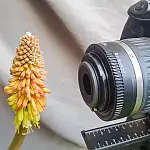How To Photograph Star Trails for Amazing Nightscapes (with Calculator)How to photograph star trails created by taking a long exposure while the Earth's rotation makes the star travel across the sky in an arc.
The key to a good star trail photograph is clarity. A long exposure will render stars as a mass of densely packed lines, as the Earth rotates on its axis. Having a static feature in the foreground helps in the composition with the movement of the stars in the background. Branches and leaves are usually not a good choice unless the wind is calm otherwise they will blur.

To make a photo with star trails, expose for the foreground then take several exposures with the same settings. Use some software such as StarTrails.exe or StarStax to stack all your images creating the final result. The resulting photograph is a representation of the apparent movement of the stars in the sky.
This is better than a single very long exposure for several reasons. You can avoid thermal noise due to sensor overheating during long exposures, and if something like an aeroplane crosses the frame you only lose one frame and not the whole picture. If the battery dies you can change it and continue.
A shutter release timer is a must-have piece of equipment for star trail photos. Program it to take as many exposures as you want with a given exposure time and then just sit and relax.
What Equipment Is Needed For Star Trail Photography?
A solid sturdy tripod is a must for star trail photography. You will generally be taking exposures from four seconds to one or two minutes, and you need the camera to remain stable during the whole exposure. A little wind can seem like a major hurricane if you use a flimsy tripod.
A remote shutter release is also an essential piece of equipment. A remote controller, such as the Canon TC-80N3. You can also use built-in timers and continuous drives if your camera supports them. You can also build your own shutter release cable.
If you want to shoot long exposure times without star trails, you might want to consider a portable tracking mount, such as the AstroTrac or Vixen Polarie. These go between two tripod heads and once aligned will follow the Earth's rotation making the stars stay around for even longer exposures. With a tracking mount exposures of one to five minutes are common with a wide-angle lens. A disadvantage is that the landscape will blur, so you have to find the maximum exposure that will make your landscape look good. Having the land features as far as you can from the camera helps.
Dealing with Noise during Long Exposures
The enemy of astrophotography is noise, and to deal with this nothing beasts sensor size. Full-frame cameras are the best for astrophotography as they have the largest sensors. Modern APS-C-sized cameras are becoming better and better, so you can also use them and get great results. Using a fast lens also helps.
Star Trail Photography Tips
- The longer the focal length, the faster the stars will trail; with a wide-angle lens you need several minutes, sometimes even hours for the effect to be nice.
- Point the camera east or west if you want the stars to move faster. The movement is slower when you aim the camera close to the celestial pole.
- If you want nice concentric circles, use a compass and point the camera to the north (if you're in the Northern hemisphere); the point of rotation known as the celestial pole will be as high in the sky as your degrees latitude. If you are shooting at 66° north, the celestial pole is 66° up towards the north.
- Noise isn't just a problem at high ISO's, it can also be a problem when using long exposures. This is why it is better to merge multiple shorter exposures.
- If your camera has built-in long exposure noise reduction, turn it off. When activated the camera tries to subtract ugly noise by taking a second dark frame. This process will double the exposure time and leaves long gaps in the star trails.
Star Trail Calculator
Without tracking or a motor-driven mount, long photographic exposures will create star trails as the Earth rotates. This gives the appearance of stars streaking across the sky, which can make interesting photos. Sometimes, however, you may want to take a photo of the stars without trails. How long exposure can I use before stars start to trail? or in reverse How long exposure do I need before star trails are shown?.
This simple calculator will tell you how many seconds before stars start to trail. Any exposure above this will have star trails, below should have no trails.
This calculator will only give a rough estimate based on the focal length of the camera and the declination of the target in degrees. Actual results will vary between lenses and cameras, so a little experimentation will be required. This tool will give a ballpark figure.
You will need JavaScript enabled to use this calculator.











